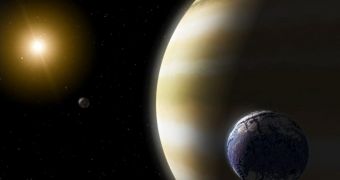The discovery of an exomoon – a natural satellite of an extrasolar planet – has been theorized ever since the first exoplanet was identified years ago. However, identifying such a small object around an alien world located thousands of light-years away has proven to be an elusive goal. Now, astronomers announce the potential discovery of the first exomoon.
For experts, there remains no doubt that many of the 1,000+ exoplanets confirmed to date have moons around them. But existing telescope, either on the ground or in orbit, are not yet sufficiently capable to see them in detail. The new NASA James Webb Space Telescope may be able to observe exomoons more effectively, astronomers say.
The reason why searching for these objects is so important is that some moons – particularly those around gas giants the size of Jupiter – may be large enough to host alien life, or at least an atmosphere. This is clearly visible on moons in our own solar system, such as Saturn's Titan and Enceladus, and Jupiter's Europa.
In the new study, which was published on December 13 on the arXiv website, researchers at the University of Notre Dame, in Indiana, led by astrophysicist David Bennett, detail how a technique called microlensing was used to reassess datasets collected by a New Zealand telescope 2 years ago.
At the time, while surveying a star in the constellation Sagittarius, the observatory detected a momentary brightening of the object, a phenomenon called microlensing, which occurs only rarely, when a planet or other non-star object passes right between a distant star and Earth.
The passing object's gravity acts like a lens, magnifying the light coming from the star behind it. The phenomenon is similar to large-scale gravitational lensing, where an entire galaxy can act as a lens for magnifying light emitted by another galaxy behind it, Nature reports.
In the new paper, Bennett's team argues that the object passing between the Sagittarius star and Earth may have been either a very small star orbited by a planet the size of Neptune, or a relatively large planet featuring an exomoon in its orbit. Unfortunately, these observations cannot be repeated.
“It’s kind of a shame because we’ll probably never know what the answer is,” explains astronomer David Kipping, who holds an appointment with the Harvard‒Smithsonian Center for Astrophysics, in Cambridge, Massachusetts. He was not a part of the new study.
It is highly unlikely that the object – whatever it was – will pass in front of the Sagittarius star ever again, or at least in the intermediate future. This is why detecting its nature is verging on the impossible. However, future telescope may come in handy in identifying moons around other exoplanets.

 14 DAY TRIAL //
14 DAY TRIAL //